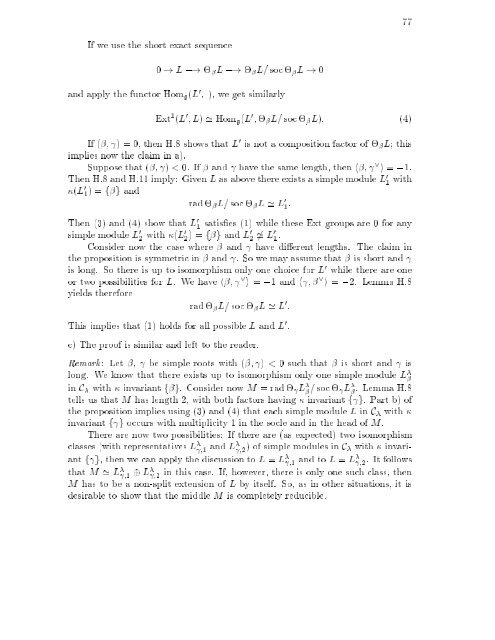subregular nilpotent representations of lie algebras in prime ...
subregular nilpotent representations of lie algebras in prime ...
subregular nilpotent representations of lie algebras in prime ...
You also want an ePaper? Increase the reach of your titles
YUMPU automatically turns print PDFs into web optimized ePapers that Google loves.
If we use the short exact sequence<br />
0 ! L ,! L ,! L= soc L ! 0<br />
and apply the functor Homg(L 0 ; ), we get similarly<br />
Ext 1 (L 0 ;L) ' Homg(L 0 ; L= soc L): (4)<br />
If ( ; ) = 0, then H.8 shows that L 0 is not a composition factor <strong>of</strong> L; this<br />
imp<strong>lie</strong>s now the claim <strong>in</strong> a).<br />
Suppose that ( ; ) < 0. If and have the same length, then h ; _ i = ,1.<br />
Then H.8 and H.11 imply: Given L as above there exists a simple module L 0 1 with<br />
(L 0 1)=f g and<br />
rad L= soc L ' L 0<br />
1 :<br />
Then (3) and (4) show that L 0 1 satis es (1) while these Ext groups are 0 for any<br />
simple module L 0 2 with (L 0 2)=f g and L 0 2 6' L 0 1.<br />
Consider now the case where and have di erent lengths. The claim <strong>in</strong><br />
the proposition is symmetric <strong>in</strong> and .Sowemay assume that is short and<br />
is long. So there is up to isomorphism only one choice for L 0 while there are one<br />
or two possibilities for L. Wehave h ; _ i = ,1 and h ; _ i = ,2. Lemma H.8<br />
yields therefore<br />
rad L= soc L ' L 0 :<br />
This imp<strong>lie</strong>s that (1) holds for all possible L and L 0 .<br />
c) The pro<strong>of</strong> is similar and left to the reader.<br />
Remark: Let , be simple roots with ( ; ) < 0suchthat is short and is<br />
long. We knowthat there exists up to isomorphism only one simple module L<br />
<strong>in</strong> C with <strong>in</strong>variant f g. Consider now M = rad L = soc L . Lemma H.8<br />
tells us that M has length 2, with both factors hav<strong>in</strong>g <strong>in</strong>variant f g. Part b) <strong>of</strong><br />
the proposition imp<strong>lie</strong>s us<strong>in</strong>g (3) and (4) that each simple module L <strong>in</strong> C<br />
<strong>in</strong>variant f g occurs with multiplicity 1 <strong>in</strong> the socle and <strong>in</strong> the head <strong>of</strong> M.<br />
with<br />
There are now two possibilities: If there are (as expected) two isomorphism<br />
classes (with representatives L ;1 and L ;2 ) <strong>of</strong> simple modules <strong>in</strong> C with <strong>in</strong>variant<br />
f g, then we can apply the discussion to L = L ;1 and to L = L ;2. It follows<br />
that M ' L ;1 L ;2 <strong>in</strong> this case. If, however, there is only one such class, then<br />
M has to be a non-split extension <strong>of</strong> L by itself. So, as <strong>in</strong> other situations, it is<br />
desirable to show that the middle M is completely reducible.<br />
77

















